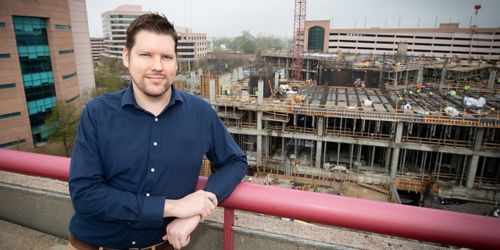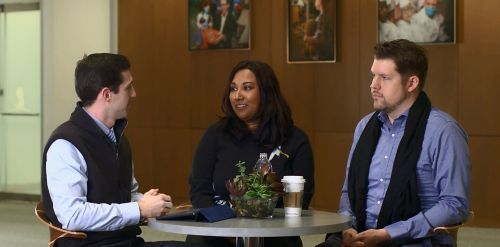St. Jude Family of Websites
Explore our cutting edge research, world-class patient care, career opportunities and more.
St. Jude Children's Research Hospital Home

- Fundraising
St. Jude Family of Websites
Explore our cutting edge research, world-class patient care, career opportunities and more.
St. Jude Children's Research Hospital Home

- Fundraising
From evolutionary biology to immunology via bioinformatics

Bioinformatics research scientist Jeremy Chase Crawford, PhD, works in the Donald P. Pinkel Research Tower (on the left) next door to the quickly rising advanced research center. He helps faculty and graduate students in the Immunology Department apply data science to solve their research problems.

This article is based in part on Jeremy Crawford’s comments from a St. Jude Talent Talks webinar (right) with fellow bioinformatics research scientist Evadnie Rampersaud, PhD, and senior recruiter John Stukenborg (left).
As a bioinformatics research scientist in the Department of Immunology at St. Jude, Jeremy Chase Crawford, PhD, helps faculty, postdocs and graduate students apply data science to their research. These scientists turn to Crawford when planning complex and cutting-edge experiments or analyzing data that they have already collected.
“As the only bioinformatics research scientist embedded within Immunology, I'm a ‘translator’ of sorts,” Crawford said, “operating at the interface of the technology and the biology.” But this doesn’t make Crawford one-of-a-kind at St. Jude. In addition to the scientists and engineers in the Department of Computational Biology, a growing number of St. Jude research departments are now staffed with bioinformaticians.
“Jeremy has played an important role in facilitating many major research advances that would have been difficult for our department to envision or carry out without him,” said Ben Youngblood, PhD, an associate member of St. Jude Immunology whose research may clear a path for more effective vaccines and new cancer immunotherapies.
Whether you call it computational biology or bioinformatics, this hybrid discipline is concerned with information and information flow in investigating biological systems, including the application of computational methods in genetics and genomics.
Rapid advances in both information technology and in biomedical sciences has reshaped this field along with Crawford’s career track. “Sometimes I spend less time analyzing data than I do devising new methods to generate data we previously didn’t think were possible to access,” Crawford said.
Steering toward a career in bioinformatics
“A new generation of sequencing technologies was emerging while I was working on my PhD research in organismal and evolutionary biology at UC Berkeley and the Museum of Vertebrate Zoology,” Crawford said. “Historically, questions in evolutionary biology have driven a lot of the advances we have made in bioinformatics, and in this case my dissertation research also required me to figure out how to leverage novel molecular approaches to push the sequencing technologies further than what we thought was possible.”
Crawford was able to use these novel approaches to investigate the evolution of the adaptive immune system. And by this point, he had decided that he didn't want to pursue a traditional, “university-centric” academic career. At the same time, he was developing a passion for pushing the new technologies and analytical tools to get the most data from his samples.
In short, in addition to becoming an innovative biologist, he had developed parallel skills in computer science.
Why St. Jude?
Crawford grew up very close to Memphis, on a farm in North Mississippi, and like many people in the region, he had previously associated St. Jude with cancer treatment. “I had not realized how much basic biological research had been going on here, and then my search for an opportunity to apply my unique skill-set led me back home. I had been gone for about half my life, and the opportunity to contribute to the mission of St. Jude was one of the main draws for me to return.”
Crawford was pleasantly surprised by the breadth of all the academic fields in which St. Jude bioinformaticians serve. “These positions are great for bioinformaticians and computational biologists interested in both broad and specialized areas of research,” Crawford said. He was also struck by the many different career trajectories that has led bioinformaticians to St. Jude. “Regardless of where you are in your academic career, there is probably an opportunity for you here at St. Jude.”
St. Jude values great ideas, and Crawford observed that researchers whose ideas show transformational potential are likely to receive the support needed to see those ideas come to fruition. “And that encourages people here to think outside the box,” said Crawford, who is able to devote 20 percent of his work schedule to independent research despite his primary duties with Immunology Department projects.
Jeremy Crawford’s favorite translational bioinformatics projects
Pediatric Acute Respiratory Distress Syndrome: “In addition to basic science research, we also interact with some amazing clinical fellows, including one who is studying therapies for pediatric acute respiratory distress syndrome (ARDS). We're only halfway through this project, but I think we've already got some great leads. This is just a great example of where current medical practices are not cutting it, so we’re taking on this challenging problem, and we’re going all in on it.”
CAR T-Cell Therapy: “A different group of clinicians and scientists is working with CAR T-cell therapy, which can redirect and amplify the power of a child’s immune system to attack the vulnerabilities of tumors and other disease. In addition to all of the clinical work, this study involves cell engineering, single-cell gene expression, epigenetics—it spans a lot of different aspects of bioinformatics, and it always keeps me on my toes.”
Full Circle: The third research project that holds great meaning for Crawford is not one for which he has provided bioinformatics support. In fact, he was only part of a human control group, made up of adults who had never had cancer, as part of the landmark St. Jude LIFE survivorship study. “My participation may have been passive, but it was also personal,” he explained. “Three generations of women in my family are cancer survivors, including my sister, who had melanoma at 13. By helping in this simple way, it felt like I had come full-circle.”






